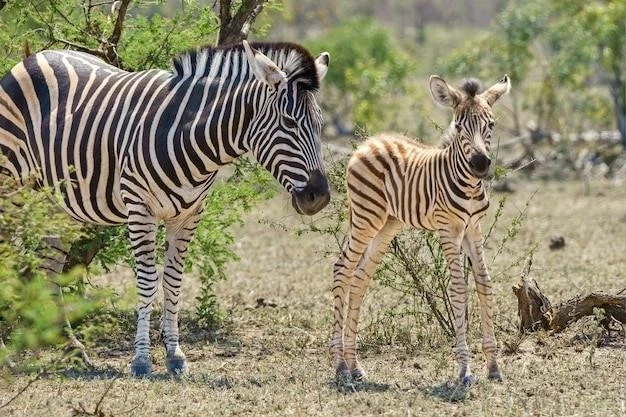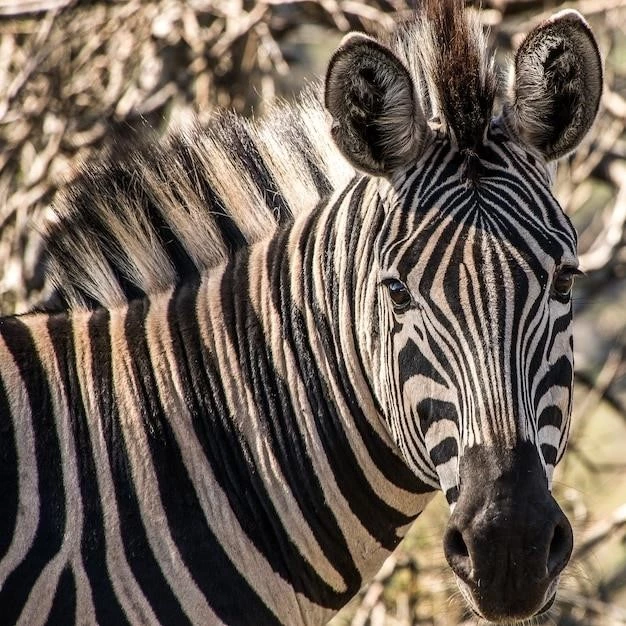Beyond the Stripes: The Social Lives of Zebras
Often seen as simply a symphony of black and white stripes against the vast African savannas‚ zebras are fascinating creatures with complex social structures and behaviors. Far from being just another equine grazer‚ these animals exhibit a remarkable level of sophistication in their interactions and family units. This article delves into the intricate world of zebras‚ going beyond their iconic stripes to understand their social dynamics‚ communication methods‚ and the challenges they face in today’s changing world.

The Power of the Herd: Zebra Social Structure
Zebras are highly social animals‚ living in structured groups with distinct hierarchies and roles. The basic social unit is the harem‚ consisting of a dominant stallion‚ several mares‚ and their foals. Let’s break down the key players in this social structure:
- The Stallion: The leader and protector of the harem‚ responsible for defending his mares and foals from predators and rival stallions. He maintains order within the group and determines the direction of their movements.
- The Mares: The core of the harem‚ forming strong bonds with each other and establishing a clear hierarchy among themselves. The most dominant mare often leads the group when foraging‚ with the stallion taking a more protective role at the rear.
- The Foals: The heart of the harem‚ adding an element of playfulness and learning to the group dynamic. Foals stay with their mothers for up to a year‚ learning crucial survival skills and social cues from the adults around them.
While harems form the foundation of zebra social life‚ these groups are not static. Young stallions will often challenge the dominant male for control of a harem‚ leading to intense‚ sometimes violent confrontations. Successful challengers will then take over the harem‚ while the displaced stallion may form a bachelor group with other males or live a solitary life until they can establish their own harem.

A Language Beyond Words: Zebra Communication
Zebras have developed a fascinating array of communication methods to navigate their social world. While their iconic stripes themselves play a role in visual communication‚ these animals also rely heavily on vocalizations‚ body language‚ and even scent to convey messages.
Vocalizations: A Chorus of Snorts‚ Barks‚ and Squeals
Zebras possess a diverse vocal repertoire‚ each sound carrying a specific meaning within their social context. Some of the common vocalizations include:
- Snorting: A versatile sound used to express alarm‚ frustration‚ or even as a greeting between familiar individuals.
- Barking: A sharp‚ short sound often used as a warning signal‚ alerting the herd to potential danger.
- Squealing: High-pitched vocalizations used to express distress‚ pain‚ or during moments of excitement.
- Whinnying: A longer‚ drawn-out sound‚ often used by mothers to call to their foals or by stallions to rally their harem.
Body Language: A Symphony of Postures and Gestures
Beyond vocalizations‚ zebras rely heavily on body language to convey messages and maintain social order. Some of the key gestures include:
- Ear Position: Flattened ears indicate aggression or fear‚ while pricked ears signal alertness or interest.
- Tail Movements: A swishing tail can express annoyance or agitation‚ while a raised tail often signifies excitement or confidence.
- Head Movements: A lowered head can be a sign of submission‚ while a high head posture indicates dominance.
- Greeting Ceremonies: Zebras engage in elaborate greeting rituals‚ touching noses‚ sniffing each other‚ and even rubbing their bodies together to reinforce social bonds.
The Power of Scent: Marking Territory and Recognition
While less obvious to the human eye‚ scent plays a crucial role in zebra social life. These animals have scent glands on their legs and use urine and dung to mark their territory and communicate with other individuals. These scent markings help zebras identify members of their own harem‚ detect the presence of rivals‚ and even signal their reproductive status.
Beyond Survival: The Importance of Social Bonds
The complex social structures and communication methods of zebras highlight the importance of social bonds for their survival. Living in cohesive groups offers numerous advantages in the harsh African savannas‚ including:
- Increased Vigilance: Multiple pairs of eyes are always on the lookout for danger‚ increasing the chances of spotting predators early on.
- Group Defense: Zebras can effectively deter or even fend off predators by forming a protective circle around vulnerable individuals‚ such as foals.
- Enhanced Foraging: Sharing knowledge about food sources and coordinating their movements allows zebras to cover more ground and locate valuable resources more efficiently.
- Social Learning: Young zebras learn crucial survival skills and social cues from observing and interacting with older‚ more experienced individuals within their harem.
A Future Uncertain: Challenges Facing Zebra Populations
Despite their remarkable adaptations and social resilience‚ zebra populations face an increasingly uncertain future. Habitat loss due to human encroachment‚ climate change‚ and competition for resources with livestock pose significant threats to their survival. Moreover‚ poaching and disease outbreaks continue to impact zebra numbers in many parts of Africa.
Conservation efforts are crucial to ensure the long-term survival of these iconic animals. Protecting their remaining habitat‚ mitigating human-wildlife conflict‚ and combatting poaching are essential steps in safeguarding zebra populations for generations to come. By understanding their complex social lives and the challenges they face‚ we can better appreciate the importance of protecting these magnificent creatures and ensuring that the African savannas continue to echo with the sound of their thundering hooves.










